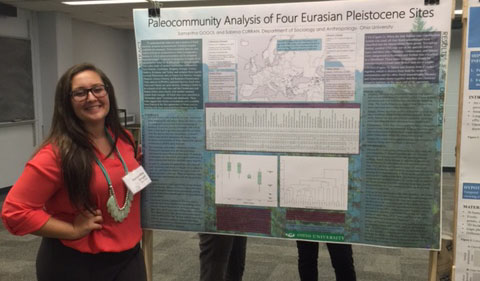
Samantha Gogol ’16, Anthropology senior, co-presented a poster with Dr. Sabrina Curran, Assistant Professor of Anthropology at Ohio University, at the Paleoecology Symposium Research Workshop held at the Cleveland Museum of Natural History in September.
Gogol’s poster, “Paleocommunity Analysis of Four Eurasian Pleistocene Sites” presented results demonstrating that modern communities in Eurasia can be used as analogs for past environments.
Curran, an invited speaker to the symposium, presented a paper, “3D morphometrics in Paleoecology”, which reviewed the various three-dimensional methods available to paleoecologists, such as geometric morphometrics and surface textural analysis.
About Gogol’s Undergraduate Research Experience
“Being at the Paleoecology Symposium was a great experience for me because I was able to interact with professionals in the field and learn more about their research, which I hope to be more involved with in the future. Also being able to present my own research at the poster session allowed me to join the ongoing conversation about how paleoecologists reconstruct past environments. I received some great feedback and formed relationships with these professionals which encouraged my passion for paleoanthropology and paleoecology.”
The Cleveland Museum of Natural History and the Institute for the Science of Origins at Case Western Reserve University co-organized this international symposium to bring together a diversity of researchers to review and synthesize current techniques and methodologies for inferring how extinct species lived and moved, determining the habitats in which they lived, and interpreting the climatic regime that affected them and their environment. These types of studies highlight the interconnectedness of organisms and their environment, a topic of vital importance for today’s ecosystems. Keeping up with the rapidly changing field of paleoecology is a challenge for professionals and students alike. Equally challenging is integrating techniques developed by specialists in varied disciplines to generate a coherent picture of an ancient environment and the animals that inhabited it. The focus of this year’s symposium was “Latest methods in reconstructing Cenozoic terrestrial environments and ecological communities.”
Poster abstract: To understand the behavior and evolution of fossil hominins, accurate reconstructions of paleoecological conditions are necessary. There are many methods available to do so, each reconstructing specific aspects of paleoenvironments. Paleocommunity analysis is one such method that uses modern ecological communities to form a comparative database to which paleocommunities can be compared based percentages of species in categories of trophic level and locomotor behavior. This method has been widely applied to the African paleorecord, but has not been used on Eurasian sites. In this poster we present results from a pilot study of modern mammalian communities from Armenia, Azerbaijan, Bulgaria, Georgia, Greece, Moldova, Romania, and Turkey and compare these regions to several Pleistocene sites in France (La Senèze), Georgia (Dmanisi), Greece (Vatera), and Romania (Graunceanu). Cluster analysis (UPGMA) indicated that two fossil sites (Senèze and Vatera) are quite distinct, forming a cluster to the exclusion of all other sites and that Graunceanu and Dmanisi cluster most closely with modern montane ecotones from Georgia. Canonical variates analysis was used to classify each fossil site into the habitat category with which it is most similar (based on modern analogs). All fossil sites were classified as ecotones, except Senèze, which was categorized as a shrubland. These results suggest that similar environments were available across Eurasia at the first appearance of Homo erectus, which has only been recovered from Dmanisi thus far.



















Comments